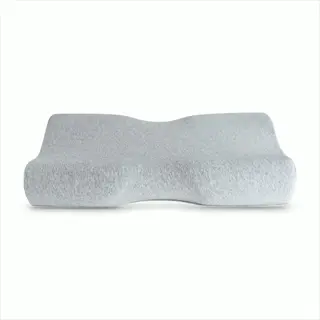Effective Neck Tension Relief Methods Explored

Written by
Leilani Ibeh
Reviewed by
Prof. Graham Pierce, Ph.D.Make neck tension relief part of your daily routine by correcting your posture and incorporating movement regularly (preferably at least once an hour).
Be strategic when using heat or cold: if using heat, allow at least 20 minutes for the heat to penetrate your muscles; with ice, 5 minutes is enough to manage inflammation.
Incorporate basic stretches like neck rotations and chin tucks into your daily routine for additional flexibility.
Consider utilizing certain yoga postures like Child's Pose for its efficacy in releasing tension in the shoulders and neck.
Use diaphragmatic breathing to help reduce muscle tightness caused by cortisol changes associated with stress.
Reject outdated ideas: movement causes greater relief than rest, and solutions should be unique to the person, rather than generalized.
Article Navigation
If you are one of the one in three adults experiencing neck tension relief, know that you are not alone. As a physical therapist, I observe how stress and poor positioning can lead to daily muscle tightness that is challenging to alleviate. It negatively affects work concentration and sleep quality. Many feel trapped in this cycle.
We will emphasize natural remedies, avoiding the use of drugs and surgery. I have personally coached individuals using the methods I will now outline. You will learn suitable stretches, useful posture correction, and intelligent stress management, which provide answers to the underlying causes and not merely to the symptoms, thus giving lasting results.
Daily Habit Optimization
Correct posture begins with your ears directly above your shoulders. This simple change relieves your cervical spine. As a physical therapist, I check this every day with postural apps and mirrors. Set your phone to remind you to check your alignment every hour. Taking two-minute breaks to move makes a huge difference.
Your sleeping position is crucial in achieving neck tension relief. Sleeping on your stomach twists your neck, while sleeping on your side requires the correct amount of pillow support. I have helped clients change cultures by using body positioning and strategic body placement. You can test mattress firmness by placing a hand under your back, which should give a little resistance without being too soft.
Supportive Self-Care Methods
Try alternating heat and cold therapy for targeted neck tension relief. Heat pads wrapped in towels for twenty minutes will help relax muscles for stretching afterward. Use ice packs for a maximum of five minutes to reduce inflammation after activity. I have found this timing combination works best in my practice.
Self-massage gives immediate results when performed correctly. Always stroke in the direction of the heart for better circulation purposes. Try also kneading tennis balls against the walls to loosen stubborn knots. I teach this to clients every week and see real gains in mobility and comfort.
Select your pillows carefully for neck support. The orthopedic style preserves the natural curves, while the cervical type is designed for optimal alignment. Drink a glass of water (8 ounces) every hour to keep your tissues hydrated and flexible. A thirsty body causes muscles to stiffen, intensifying the tension we experience all day.

Heat Therapy
- Application: Use heating pad wrapped in towel for 20 minutes, three times daily to relax tense muscles.
- Timing: Apply before stretching sessions to increase blood flow to stiff neck and shoulder areas.
- Alternatives: Warm showers provide similar benefits by loosening tight muscles when pads unavailable.
- Precautions: Avoid sleeping with heating pads to prevent skin burns or excessive dehydration.
- Effectiveness: Particularly beneficial for chronic tension from poor posture or stress buildup.
- Temperature: Maintain between 104-113°F (40-45°C) for optimal muscle relaxation without risk.

Cold Therapy
- Application: Apply ice packs wrapped in cloth for 5-minute sessions, three times daily.
- Purpose: Reduces inflammation in acute neck strain or after intense stretching exercises.
- Timing: Most effective within first 48 hours of injury or severe muscle discomfort.
- Alternatives: Frozen vegetable bags offer flexible contouring around neck and shoulders.
- Precautions: Never apply ice directly to skin to prevent frostbite or nerve damage.
- Combination: Alternate with heat therapy for chronic conditions to address both pain and stiffness.

Self-Massage Techniques
- Method: Use kneading motions moving toward heart to promote lymphatic drainage and circulation.
- Tools: Tennis balls against walls target shoulder blade knots and upper back tension.
- Pressure: Apply moderate pressure using fingertips or palms without causing bruising.
- Duration: 3-5 minute sessions hourly during desk work prevents muscle stiffness buildup.
- Oils: Warm coconut or almond oil enhances glide and provides additional relaxation.
- Focus Areas: Concentrate on trapezius muscles and base of skull where tension accumulates.

Supportive Equipment
- Pillows: Orthopedic designs maintain cervical curve during sleep with memory foam support.
- Setup: Position laptop stands to keep screens at eye level during prolonged work.
- Cushions: Lumbar supports maintain spinal alignment reducing compensatory neck strain.
- Portability: Travel-sized heating pads provide on-the-go relief during commutes.
- Selection: Choose firmness based on sleep position - medium for side, soft for back.
- Maintenance: Wash pillow covers weekly to prevent allergen buildup affecting breathing.

Hydration Support
- Quantity: Consume 8 oz (240 ml) water hourly to maintain muscle elasticity.
- Timing: Drink before stretching sessions to optimize tissue pliability and movement range.
- Electrolytes: Add pinch of sea salt to water for better mineral absorption.
- Tracking: Use marked bottles to monitor daily intake goals for hydration.
- Benefits: Proper hydration prevents muscle cramps and supports toxin removal.
- Alternatives: Herbal teas like chamomile provide hydration without caffeine effects.
Essential Stretch Routine
Perform neck stretches correctly to relieve tension. Sit with good posture and gently pull your head to one side until you feel a stretch. Hold for 30 seconds without bouncing. If this is done properly, each side should be repeated 3 times. This method will safely relieve muscle tension. I recommend it to my clients daily.
Slowly tilt your head to the left and to the right. Place your chin on your chest and slowly raise it, stretching it towards the ceiling. Bring your right ear towards your right shoulder and hold it for five seconds at each point. These are good stretches because they will lubricate the joints without stress. These should be done in groups of five, both in the morning and at night.
Breathe in time with shoulder blade squeezes. Breathe in as you squeeze your shoulder blades together. Breathe out as you release your shoulder blades. Keep this going for 30 seconds. This is a good posture exercise. Keep feet flat and spine straight. This exercise helps alleviate rounded shoulders caused by desk work.
Slow neck rotations nourish discs. Turn your head fully left, then right, without applying strain. Three slow controlled rotations each way. This action pumps nutrients into the cervical tissues. I've seen clients gain mobility by using this simple technique regularly.
Neck Stretch
- Technique: Stand tall with left arm at side, place right hand on head with fingers pointing left
- Execution: Gently pull head toward right until stretch felt on left neck side, hold 30 seconds
- Frequency: Repeat 3 times per side to improve range of motion and relieve tension
Head Tilts
- Forward/Backward: Bring chin to chest, pause, then lift chin toward sky, repeat 5 times
- Side Movements: Bring right ear toward right shoulder, hold 5 seconds, repeat left side
- Benefits: Increases cervical flexibility without joint strain from rolling motions
Shoulder Blade Squeezes
- Position: Sit upright with feet planted firmly, spine elongated, shoulders relaxed down
- Action: Gently squeeze shoulder blades together while inhaling deeply through nose
- Hold Duration: Maintain squeeze for 30 seconds during exhalation, repeat 4 times
Neck Rotations
- Technique: With shoulders down and elbows bent, slowly turn head fully left then right
- Sequence: Perform 3 complete rotations per side at controlled pace without forcing
- Benefits: Wrings out disc waste products while allowing fresh nutrient absorption
Chin Tucks
- Position: Sit or stand with spine straight, eyes looking straight ahead level
- Movement: Slide head backward without tilting, creating double-chin appearance
- Hold: Maintain tuck while breathing deeply 3 times to strengthen neck flexors
Yoga for Tension Release
Child's Pose is the perfect starting pose for releasing tension fully. Kneel with your hips on your heels and stretch your arms forward, resting your forehead down. Inhale and lengthen your spine, then exhale into it and allow your body to sink deeper into relaxation. Do this for a count of ninety seconds. Concentrate on the patterns of your breath and let the tension move away.
Coordinate breath with movement in Cat Cow. On all fours, inhale while arching your back upward. Exhale, rounding your spine. Do twelve slow repetitions. This mobilizes stiff vertebrae. I teach this daily and notice clients release trapped tension between their shoulder blades.
The thread the needle loosens tight muscles in the rotator cuff area by starting in the tabletop position. Slide one arm under the opposite shoulder, palm up, and roll along the torso until the shoulder touches the mat. Hold for thirty seconds on either side. This exercise opens a suddenly restricted area gently.
To achieve the best results, aim to practice for eight to ten minutes a day. Consistency is more important than time. I have witnessed my clients transform chronic tension using a daily, consistent approach. If possible, link your movements to intentional breathing, and you will further enhance the benefits of the release.
Child's Pose (Balasana)
- Position: Kneel with hips on heels, arms extended forward, forehead resting on mat
- Execution: Inhale to lengthen spine, exhale to deepen fold, hold 90 seconds
- Benefits: Releases neck/shoulder tension, calms nervous system, promotes relaxation
Cat-Cow (Chakravakasana)
- Position: Tabletop stance with wrists under shoulders, knees under hips
- Flow: Inhale arch back (Cow), exhale round spine (Cat), 12 slow repetitions
- Benefits: Mobilizes cervical spine, relieves stiffness between shoulder blades
Thread the Needle
- Position: Start in tabletop, slide right arm palm-up under left shoulder
- Execution: Rotate torso until right shoulder touches mat, hold 30 seconds per side
- Benefits: Targets rotator cuff tension and upper back muscular knots
Neck Release Sequence
- Movements: Slow side-to-side head tilts followed by chin-to-chest folds
- Technique: Maintain shoulders down during 3 full rotations each direction
- Benefits: Improves cervical range of motion and disc nutrient circulation
Supported Fish Pose
- Setup: Place folded blanket under upper back, head relaxed backward
- Hold: Maintain gentle backbend for 2 minutes with deep diaphragmatic breaths
- Benefits: Counteracts forward head posture and opens anterior neck muscles
Stress Management Techniques
Use deep belly breathing to break the cycle of stress. Put your hands on your abdomen and inhale deeply through your nose. Feel your abdomen fully expand like a balloon. Then exhale slowly through pursed lips for double the time taken for the inhalation. Practice for five to seven minutes each day.
Progressive muscle relaxation systematically helps to relieve physical tension. Begin to tense your muscles and then relax them, starting with your toes and working your way up. Tense for five seconds, each group, then relax completely. Spend ten minutes focusing on the sensation of release. This is very effective in breaking chronic patterns of muscle holding.
Mindfulness meditation requires a position where the back is straight and the spine is aligned. Sit up with the spine upright and keep the hands in a comfortable position. Anchor yourself on the breath for 10 minutes. When your thoughts wander away from the breath, gently bring them back to it. This helps develop awareness of the present moment, which decreases tension due to anxiety.
Apply the methods twice a day to achieve the most benefits over time. Morning practice creates a foundation of calm, while evening practice prepares the body for restful sleep. Daily practice modifies the mind's response to stress. I've seen clients alter tension patterns in their bodies within three weeks when the practices are implemented daily.
Diaphragmatic Breathing
- Technique: Place hands on belly, inhale deeply through nose allowing abdomen to expand fully
- Rhythm: Exhale slowly through pursed lips for twice inhalation duration, 5-7 minute sessions
- Benefits: Activates parasympathetic nervous system to reduce cortisol and muscle tension
Progressive Muscle Relaxation
- Sequence: Tense then release muscle groups from toes to forehead systematically
- Execution: Hold tension 5 seconds per group, focus on release sensation, 10-minute routine
- Benefits: Breaks chronic muscle holding patterns in neck and shoulders caused by stress
Mindfulness Meditation
- Posture: Sit upright with spine straight, hands resting comfortably on thighs
- Focus: Anchor attention to breath, gently return focus when mind wanders for 10 minutes
- Benefits: Reduces anxiety-triggered muscle tension through present-moment awareness training
Guided Visualization
- Practice: Listen to nature-sound recordings while imagining peaceful scenes for 8-10 minutes
- Elements: Incorporate sensory details - visualize warm sunlight melting shoulder tension
- Benefits: Lowers heart rate and blood pressure while releasing physical stress responses
Movement Meditation
- Form: Slow tai chi or qigong movements synchronized with deep breathing patterns
- Duration: 5-minute sessions focusing on fluid shoulder and neck motions twice daily
- Benefits: Combines physical stretching with mental focus to disrupt stress feedback loops
5 Common Myths
More than anything else, resting your neck completely is what will relieve tension and keep you out of further trouble during healing times.
Short resting spells may help with acute injuries, but long inactivity actually weakens the neck muscles and circulation, thus prolonging recovery methods. Gentle movements are what makes blood circulate and feeds the needed nutrients to the tense muscles, and slow stretching is what maintains mobility and keeps stiffness from turning into a chronic pain patter.
Cracking or popping your neck provides effective tension relief by releasing trapped gases in the joint spaces between vertebrae.
Neck cracking forces joints beyond their normal range of motion, potentially damaging ligaments and causing joint instability over time. This habit increases wear on cervical facet joints and may lead to hypermobility, while the temporary relief comes from endorphin release masking underlying muscle tension rather than resolving it sustainably.
Simply performing neck exercises will not alleviate tension and pain without taking into account other contributing lifestyle factors.
While exercises produce muscle strengthening, the rendering of relief must take into account all other contributing factors which include, but are not limited to, poor posture during work, bad sleeping positions, chronic stress responses, and ergonomic setup problems. The most effective means of accomplishing relief is to utilize a holistic approach comprising movement as well as posture correction and stress management and proper equipment use than by mere performance of exercises.
Serious tissue injury or structural problem requiring clinical intervention to be properly resolved is indicated by all neck pain.
Most tension in the neck is due to muscle strain from stress or posture, and most neck pain is due to a structural deficiency. This type of pain is corrected with conservative therapy, i.e. muscle stretching and heat therapy. Persistent numbness or radiating pain should be evaluated, but the usual tension or chordal response to self-management techniques gives no evidence of any underlying pathology going for the prime majority of cases.
There is only one solution that suits all people who suffer from differing types of discomfort in the neck!
Relief can only be obtained if the solution is individual, since the origin of the discomfort arises from causations that are of the widest variety, the cases of "tech neck" being benefited by posture cures, and cases of stress and tension being aided by relaxation. Individual items such as the kind of work engaged in, rest habits, the amount of stress encountered, the physical history all indicate what is the best way to eliminate the discomfort. This makes individual treatment satisfactory, while treatments that are generic cannot be of equal efficiency for all.
Conclusion
Routine morphs neck tension relief. Incorporate daily stretching combined with habit tracking such as: posture checks and water intake logs. I advise clients to record their progress in easy journals. Small consistent actions create lasting change more effectively than intermittent intensive effort. This develops sustainable routine.
Begin slowly to avoid overwhelm. Choose one from each section. For example, correcting postures from habits, heat therapies from self-care, and neck rotations from stretches. Try doing the ones listed before introducing yoga or meditation, building up confidence while developing habits for relief.
If the tension lasts longer than two weeks, please seek professional help. Physical therapists will look at the patterns of movement, and the stress specialists will assess the anxiety parts. Early intervention keeps problems from becoming chronic. I send my clients to specialists if the home treatment becomes stagnant so that they can receive individualized treatment for the stubborn tense areas.
A reduction of tension in the neck directly impacts productivity and the quality of life. Clients have reported clearer thinking and improved sleep quality as a result of doing this work. Most movements allow a return to normal alignment, releasing energy for total engagement in daily activities. Frequent practice leads to noticeable improvements in concentration and physical comfort.
External Sources
Frequently Asked Questions
How do you release tension in your neck?
Effective neck tension relief combines daily stretches, posture correction, and stress management. Prioritize gentle neck rotations, heat therapy for muscles, cold therapy for inflammation, and ergonomic adjustments during work. Consistent movement breaks every hour prevent muscle stiffness buildup.
Where are pressure points to relieve neck tension?
Key pressure points for neck tension relief include:
- Base of skull (occipital ridge) where neck meets head
- Top of shoulders near trapezius muscle origins
- Between shoulder blades along spine alignment points
- Temple areas connecting to temporal muscles
Why do I hold tension in my neck?
Neck tension accumulates from sustained poor posture, emotional stress responses, repetitive movements, and muscle imbalances. When stressed, shoulders instinctively rise toward ears, while desk work strains cervical vertebrae through forward head positioning, creating chronic tightness patterns that require conscious release techniques.
How to release emotional tension in neck?
Releasing emotional neck tension requires mind-body techniques:
- Diaphragmatic breathing activates parasympathetic relaxation response
- Progressive muscle relaxation systematically releases held tension
- Mindfulness meditation disrupts stress-pain feedback loops
- Guided visualization redirects focus from anxiety triggers
What are signs of chronic neck tension?
Chronic neck tension manifests through persistent stiffness limiting rotation range, frequent tension headaches originating at skull base, palpable muscle knots in trapezius, referred pain to shoulders/arms, and compensatory postural changes like rounded shoulders or forward head positioning.
Can anxiety cause tight neck muscles?
Yes, anxiety directly triggers neck muscle tightness through fight-or-flight responses. Stress hormones cause shoulder elevation and jaw clenching, creating sustained contraction in cervical muscles. This tension loop worsens without conscious relaxation techniques like breathwork and movement meditation.
What are red flags for neck pain?
Serious neck pain indicators requiring immediate medical evaluation include:
- Radiating numbness/tingling down arms or legs
- Bladder or bowel control difficulties
- Severe pain following trauma or accidents
- Unexplained fever with neck stiffness
How to release trigger points in neck?
Releasing neck trigger points involves targeted pressure application:
- Use tennis balls against walls to isolate knots
- Apply sustained finger pressure for 30-second intervals
- Combine with heat therapy to increase blood flow
- Follow with gentle stretching to restore mobility
Why won't my neck muscles loosen up?
Persistent neck tightness often indicates unaddressed root causes like ergonomic misalignments during sleep/work, chronic stress patterns, or muscle imbalances. Without comprehensive solutions including posture correction, stress management, and consistent stretching, muscles remain stuck in protective tension patterns.
What kind of doctor treats neck pain?
Neck pain specialists include physical therapists for movement rehabilitation, orthopedic doctors for structural issues, neurologists for nerve-related symptoms, and pain management specialists for chronic conditions. Start with primary care for evaluation and appropriate referrals based on symptom presentation.

